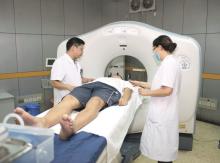More even after researchers controlled for tumor histology and recurrence.
Compared with those followed every 3 months, the hazard ratio for 6-month follow-up with CT scanning was 1.16, and 1.06 for annual follow-up – a nonsignificant difference. Nor did more frequent imaging improve survival among the subgroup of patients who were cancer free 9 months after their surgery or among those who had recurrences, Timothy L. McMurry, PhD, and his colleagues reported in the Annals of Surgery. The paper was presented at the annual meeting of the American Surgical Association.
The results probably reflect the very poor survival rates of any patients who develop recurrent non–small cell lung cancer (NSCLC), wrote Dr. McMurry, a biostatistician at the University of Virginia, Charlottesville, and his coauthors.
“Surveillance recommendations need to be considered in the context of potential harms and benefits to patients and their caregivers,” they said. “Follow-up imaging and office visits increase cost and can lead to patient anxiety. Although it seems intuitive that earlier detection of asymptomatic recurrence could improve outcomes, patients with recurrent NSCLC do very poorly … poor survival after recurrence helps explain why more intense surveillance after surgical resection was not associated with improvement in overall survival.”
However, they noted, treatment advances for recurrent and metastatic disease may already be changing the outlook for these patients, “systemic therapy and targeted agents are demonstrating clinically significant survival benefits for small patient subgroups, which, in the future, may augment the benefits of early recurrence detection.”
The team undertook this retrospective study – the largest of its kind in NSCLC patients – in light of current follow-up recommendations that are based almost solely on expert consensus, with low-level data.
“Because there is a paucity of high-quality data on NSCLC surveillance, practice guidelines are based on small retrospective analyses and expert opinion. This results in wide variation in practice including both underuse and overuse of surveillance services.”
The study plumbed the National Cancer Database, extracting information on patients who underwent surgery for NSCLC stages I-III during 2006-2007. All had complete resection and negative margins. Patients were followed through 2012, or until they had a recurrence, a new primary cancer, or they died.
The cohort comprised 4,463 who were followed with CT imaging: 1,614 every 3 months, 1,999 every 6 months, and 850 annually. These intervals correspond to the three different major recommendations. The most common procedure was a lobectomy (about 80%). Patients with higher-stage cancers were significantly more likely to receive more frequent imaging. The regression model controlled for age, sex, comorbidities, tumor stage, and surgical procedure.
After 14 months, 3,552 patients (79.5%) were alive and cancer free. However, during the rest of the follow-up period, 11% developed a new primary cancer and 24% a recurrence of their lung cancer, with no between-group differences. The regression analysis showed no significant difference in recurrence related to surveillance interval, whether 6 months was compared with 3 months (hazard ratio, 1.16) or 1 year with 3 months (HR, 1.06).
Results were much the same for the subgroup of 3,165 who were alive and cancer free 9 months after surgery. In this group, 11% developed a new primary cancer and 29% a recurrence of their lung cancer, with similar numbers in each of the surveillance groups (HR, 1.12 for 6 months vs. 3 months).
Finally, a model including only those who had recurrence, new cancers, or were lost to follow-up within 14 months of surgery also showed no benefit for more frequent surveillance.
“More recent prerecurrence imaging was not associated with postrecurrence survival (HR, 1.02 per month since imaging), and patients who had gone more than 14 months without imaging were at no greater risk of death (HR, 1.01),” the investigators wrote.
The significant predictors of worse survival were nothing surprising, the authors noted. These included symptomatic recurrence (HR, 1.49), distant recurrence, age, male sex, congestive heart failure, coronary artery disease, and peripheral vascular disease.
The findings are not to say, however, that CT surveillance confers no benefit, the authors noted.
“Historically, 5-year survival for the earliest stage of lung cancer, stage IA, was only 70%. Increased use of CT scanning has, however, resulted in a decrease in the median tumor size of resected NSCLC and a shift toward earlier-stage disease. … The National Lung Screening Trial prospectively evaluated annual low-dose screening CT scans and demonstrated a 20% reduction in mortality from lung cancer. This enormous improvement in survival for NSCLC patients provides great promise for the future and is likely to increase the volume of lung cancer resections performed and the number of lung cancer survivors needing routine surveillance.”
However, the data do show that “at least annual CT surveillance is appropriate but that there is no benefit to more than biannual surveillance.”
The authors reported no financial conflicts.
SOURCE: McMurry TL et al. Ann Surg 2018 Jul 12. doi: 10.1097/SLA.0000000000002955.


